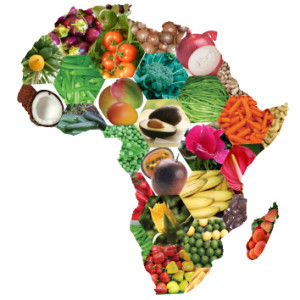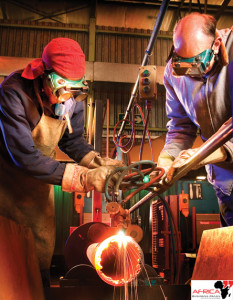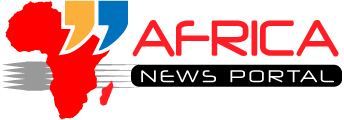In support of its efforts to highlight attractive investment opportunities in Africa to its members, new research by the Dubai Chamber of Commerce & Industry entitled “Beyond Commodities: Gulf Investors and the new Africa”, has highlighted that co-investment with private equity funds, purchase of private equity businesses, and direct buyouts or minority share acquisition represent the most significant modes of FDI entry for Gulf investors interested in Sub-Saharan Africa.
 The study, produced in collaboration with The Economist Intelligence Unit, analysed Gulf investment into Africa, opportunities available to investors, and the investment vehicles they can use to enter African markets. It also sheds light on the continents’ most promising non-commodity sectors.
The study, produced in collaboration with The Economist Intelligence Unit, analysed Gulf investment into Africa, opportunities available to investors, and the investment vehicles they can use to enter African markets. It also sheds light on the continents’ most promising non-commodity sectors.
The study was launched during a press conference on the sidelines of the Third African Global Business Forum, hosted by Dubai Chamber recently at the Atlantis Hotel in Dubai. And it revealed a number of factors that make gulf investment into these sectors particularly attractive: Demographic trends, growing consumer markets, economic stability and an improving business environment, as well as a resilience that has allowed it to withstand global recession and the current commodity price slump.
The study also found that East Africa was the most appealing region for non-commodity investment from the Gulf, with retail and hypermarkets, automotives, commercial banking and tourism considered key sectors. Manufacturing in Ethiopia, leisure, retail and tourism in Mozambique and Kenya, and education in Uganda were also popular with Gulf investors.
H.E. Hamad Buamim, President & CEO of Dubai Chamber deemed it a duty towards its members and the wider investment community to make research like this available, given the current dearth of detailed and specialized economic studies, and noted that the EIU study contains insights around sectors that UAE companies hold an eminent and competitive position in, in particular corporate banking, retail, tourism, and logistics. He also noted that the research the Chamber conducts is backed by a significant on-ground presence in Africa, which helps to identify opportunities for UAE companies, helping to increase their presence in the process.
Buamim also noted that most studies and global indicators point towards a future that is very bright in Sub-Saharan Africa, and so “we’re putting our trust in these markets that we think will drive the engine of growth in the region, ensuring that Dubai Chamber is, once again, at the forefront of the investment community, and committed to ensuring that all our capabilities are being used to reinforce the competitive nature of the private sector in Dubai, mirroring the high reputation that Dubai has managed to build for itself in such a short space of time.”
Buamim added that the Dubai Chamber aims to encourage Gulf investors to expand trust beyond the borders of North Africa, which currently makes up the bulk of Gulf investment, pointing the opportunities in sectors as diverse as logistics, hospitality, retail and corporate banking.
The study showed that Gulf investors have three potential modes of entry into the African market: co-investment with private equity funds, purchase of private equity businesses, and direct buyouts or minority share acquisition. It also found that outside of South Africa, stocks and shares remain of limited interest to Gulf investors
It also found that malls and hypermarkets are emerging in a handful of countries, noting that Gulf companies have a comparative advantage thanks to a track record in franchising and adapting brands to local tastes and cultures. These firms are also skilled at managing the logistics of multi-country distribution.

East Africa
The study also drew attention to the role Gulf airlines have played a role in opening Africa to international tourists, with Gulf investors owning around 20 hotels and resorts in Sub-Saharan Africa. However, the need to improve logistics in FMCG was also noted- which remains challenging due to weak infrastructure. Gulf firms have experience to share but only a few are exploring investment in Africa at the moment.
The study highlighted data from the African Development Bank which shows that average real GDP growth across the continent was 6.1% in 2010-14 and per capita income rose by nearly 60% to US$1,788, according to EIU estimates. The research forecast a deceleration to 4.1% in 2015, mainly due to the commodity price shock, before a pick up to 5.1% in 2016. In addition, the IMF forecasts average growth of 5.3% from 2017-2020.
The study also underlined the importance of the average rate of population growth across Africa, which is 2.7%, compared with a global average of 1.1% (and 0.5% in China). The mid-case in the latest UN population forecasts see sub-Saharan Africa’s population ballooning from 962m in 2015 to 1.4billion in 2030 and eventually to 3.9billion at the end of the century, when it will host a third of humanity.
The study also found that one widespread economic stabilisation trend in Africa has been reduced debt, thanks to a string of bilateral and multilateral initiatives which cancelled a large part of the external debts of Sub-Saharan Africa, bringing government debt down to 30% of GDP in 2014, from 67% in 2000, according to IMF data.
Africa’s Economic Resilience
Whilst the continent has been affected by negative global headwinds, including the commodity price slump- demographic trends, growing consumer markets, economic stability and an improving business environment have all helped. As will the planned Tripartite Free Trade Area- important in a continent with so many small and landlocked countries.
Africa and the Gulf
The study indicated that whilst the GCC and Africa have strong geographic and cultural connections, these have not necessarily translated into more than modest trade. In 2014, GCC exports to Sub-Saharan Africa totalled US$19.7billion, according to IMF data, which was just 2% of the GCC’s total exports. Meanwhile, the GCC only received US$5.5billion of imports from Africa, most of which were destined for the UAE, partly for re-export.
However, according to the research, direct investment flows are growing. A number of pan-African companies have relocated their headquarters to Dubai, boosting links between the Gulf and Africa. These include Stallion Group, the second largest conglomerate in Nigeria and active across West Africa, Atlantic Holdings of Ghana and Mara Group of Kenya.
According to data from FDi Markets, Gulf firms provided at least US$9.3bn in foreign direct investment into Sub-Saharan Africa in the decade 2005-14, plus a further US$2.7bn in the first half of 2015, more than in any previous full year. It’s important to note that during this time, Gulf countries invested nearly ten times as much in North Africa over the same period, demonstrating closer links with fellow Arab countries.
The Sub-Saharan African countries which have attracted the largest number of Gulf investors during this time—between 10-25 firms each—are Nigeria, South Africa, Kenya and Uganda.
Gulf Investors are protected in parts of the continent through multilateral investment treaties—Mauritania, Somalia, Djibouti and Comoros are all covered by the Arab League’s investment treaty—while 21 countries, from Senegal to Mozambique, are members of the OIC, which has its own internal investment treaty.
The study also highlighted private equity investment options, where Abraaj continues to lead the way- in April 2015 closing its third Africa-focused fund with US$1bn in subscribed capital. Other Gulf private equity firms active in Africa include Swicorp of Saudi Arabia and Kappafrik Group in Dubai. Gulf companies can also make direct investments, either for minority or controlling stakes, in private African companies. The most prominent Gulf investments into listed African companies so far, both in 2014, have been QNB’s purchase of a 23% stake in Ecobank of Togo and the Investment Corporation of Dubai’s US$300m investment into Dangote Cement of Nigeria.
Another entry method is acquiring a company with regional coverage located in an advantageous country with a pro-business environment. An example is Etisalat’s 2014 purchase of a majority stake in Maroc Telecom, which has a network of subsidiaries across West Africa. Etisalat subsequently folded its pre-existing holdings in six West Africa countries into the Maroc Telecom Group, which is better placed given its regional expertise, language skills and experience managing a low-income customer base.
Another joint-investment route, often favoured by Gulf sovereign wealth funds, is to partner with the government of the recipient country itself. An example of this is Saudi Arabian South Africa Holding, established by the two countries in 2012 to identify co-investment opportunities. This model does not appear to have been utilised elsewhere in Sub-Saharan Africa, but is a familiar feature of Gulf sovereign wealth fund investment in other countries.
Salient Points
- Gulf firms provide US$2.7bn in foreign direct investment into Sub-Saharan Africa in the first half of 2015, and a total of US$9.3billion from 2005-14
- Nigeria, South Africa, Kenya and Uganda have attracted the largest number of Gulf investors’ between 10-25 firms each
- Financial services, retail, tourism and logistics represent the most favored sectors by Gulf investors
- Gulf investors own 20 hotels and resorts in Sub-Saharan Africa
- Average growth prediction of 5.3% for the continent in 2017-2020
- Sub-Saharan Africa’s population will host a third of humanity by the end of the century
- National Bank of Abu Dhabi, National Bank of Qatar amongst the most notable investors in financial services sector; MAF Group and Landmark in retail
- Rani Investments and Kingdom Holdings of Saudi Arabia, as well as Kuwait’s IFA group the most notable investors in tourism sector
- DP World, Kuwait’s Agility, and Aramex the most active in the logistics sector; Julphar, Abraaj, Kuwait’s Al Bader group in manufacturing
Financial Services
Inadequate access to financial services, including banking and insurance, has long been a barrier to development in Africa. However, the study noted two major GCC banks that have put Africa at the heart of their expansion plans. Qatar National Bank, the GCC’s largest and most widely spread bank, as well as National Bank of Abu Dhabi, which has positioned itself as a central location on a global “West-East Corridor” of rapidly-growing economies. It aims to open a branch in Nigeria, as does Mashreq, which is considering offices in Kenya and Nigeria. However, a physical presence is not a necessary requirement for involvement in major deals. An Emirates NBD-led consortia of GCC banks is providing syndicated loans of US$85m for Stanbic Bank of Uganda and US$125m for FirstRand in South Africa.
Islamic finance is perhaps where the Gulf’s involvement is most pronounced. Kuwait Finance House arranged South Africa’s first sovereign sukuk, an oversubscribed US$500m issue in 2014. It was only the second time a non-Muslim country had drawn on Islamic financing. There is likely to be a growing demand for Islamic finance moving forward, given that about 30% of the sub-Saharan population are Muslims, have the region’s highest birth rates and form a sizable minority in key growth countries such as Nigeria and Ethiopia. The study found that there are also significant opportunities in the fields of insurance and remittances.
Retail: Tapping Africa’s consumer class
African retail presents a huge opportunity, as the continent’s population grows and becomes increasingly urban. Although the majority of the population still shop at open air-markets or small local stores, this is changing in many cities as disposable incomes levels increase, transport options improve and the appetite for international brands grows, helped along by the spread of the internet.
The study highlighted three sectors that are well-developed in the Gulf and could provide a platform for expansion into Africa: automotive sales, hypermarkets and franchise stores. The most significant automotive investment by a Gulf player was the US$86m purchase by Majid Al Futtaim (MAF) Group of the UAE in 2014 of Kenya’s CMC, which has dealership rights for brands including Ford, Volkswagen and Suzuki in Kenya. MAF has also taken the first step into hypermarkets, leasing a sixth of the new Mall of Kenya, which will be the biggest mall in ‘Middle Africa’, and Landmark Group already has 13 stores across Nigeria, Tanzania, Kenya and Zambia.
Travel and Tourism
The World Travel and Tourism Council estimates that the travel and tourism sector directly comprises about 3.5% of African GDP, with a total contribution, including indirect and induced expenditure, of 8.4%, which is below the global average for the sector.
According to the World Bank, countries with the most developed tourism sectors are South Africa, Ghana, Tanzania and Kenya, while the sector is emerging in a number of others including Gambia, Mozambique and Rwanda .
In addition to its airlines playing a pivotal role in opening up Africa to visitors from around the world through direct flights and codeshares, the GCC has done the same with its local hospitality expertise. The most active investors in this space have been Bahrain’s Gulf Hotels Group, KSA’s Rani Investment & Kingdom Holdings, which manages seven hotels in Kenya, Ghana, Zambia, Seychelles and Mauritius. For its part, Kuwait’s IFA Resorts & Hotels manage five hotels in South Africa and Zanzibar. The study also notes that both the Rotana and Jumeirah currently have plans to enter the East African media.
Manufacturing
The study also noted that the manufacturing industry’s contribution to GDB has fallen from 18% of GDP in 1975 to just 11% in 2013, with a number of significant barriers, including the need for a reliable energy supply, transport infrastructure, skills, finance, and market access, currently in the way. So although a few countries—such as South Africa, Senegal, Kenya  and Cote d’Ivoire—have more prominent manufacturing sectors, they are still smaller than the global average. The most prominent Gulf investors in this sector are Julphar, Abraaj and Kuwait’s Al Bader Group.
and Cote d’Ivoire—have more prominent manufacturing sectors, they are still smaller than the global average. The most prominent Gulf investors in this sector are Julphar, Abraaj and Kuwait’s Al Bader Group.
Logistics
Poor infrastructure has made logistics expensive for companies in every sector, including logistics, with the most prominent Gulf players in this sector DP World, Aramex and Kuwait’s Agility, in addition to aviation sub-sectors like refuelling and ground handling. Opportunities are currently most apparent in Mozambique, Tanzania, Angola, Nigeria and Ghana.
Social Sectors
The study also notes that the growth of the middle class in Africa is stimulating demand for private healthcare and education, with Dubai’s Aster DM Healthcare the main investor. And on the education front, GEMS Education already operates schools in Kenya and Uganda and has ambitious expansion plans across the continent.
Data Services
Much of Africa still lags behind in terms of the coverage and speed of broadband access, the key enabler for ecommerce, with data costs proving to be particularly exorbitant according to the research. As smartphones become more ubiquitous, and data services improve, there will be more opportunities for Gulf investors to transform the digital sectors.
Gulf investors could provide seed capital to African start-ups, such as those emerging around incubators. There are also potential opportunities to invest in more established companies involved in building the infrastructure of the internet across Africa, who need capital to scale up rapidly in response to growing demand for data.















